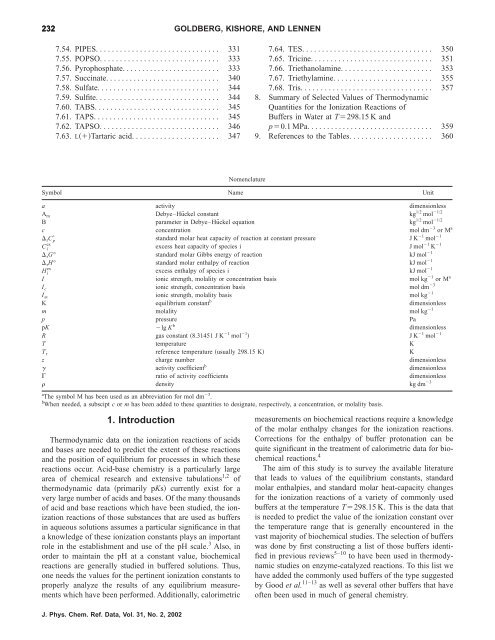Thermodynamic Quantities for the Ionization Reactions of Buffers
Thermodynamic Quantities for the Ionization Reactions of Buffers
Thermodynamic Quantities for the Ionization Reactions of Buffers
You also want an ePaper? Increase the reach of your titles
YUMPU automatically turns print PDFs into web optimized ePapers that Google loves.
232 GOLDBERG, KISHORE, AND LENNEN<br />
7.54. PIPES............................... 331<br />
7.55. POPSO.............................. 333<br />
7.56. Pyrophosphate......................... 333<br />
7.57. Succinate............................. 340<br />
7.58. Sulfate............................... 344<br />
7.59. Sulfite............................... 344<br />
7.60. TABS. . . . ............................ 345<br />
7.61. TAPS................................ 345<br />
7.62. TAPSO. ............................. 346<br />
7.63. LTartaric acid...................... 347<br />
Nomenclature<br />
7.64. TES................................. 350<br />
7.65. Tricine............................... 351<br />
7.66. Triethanolamine. . . . . . ................. 353<br />
7.67. Triethylamine......................... 355<br />
7.68. Tris................................. 357<br />
8. Summary <strong>of</strong> Selected Values <strong>of</strong> <strong>Thermodynamic</strong><br />
<strong>Quantities</strong> <strong>for</strong> <strong>the</strong> <strong>Ionization</strong> <strong>Reactions</strong> <strong>of</strong><br />
<strong>Buffers</strong> in Water at T298.15 K and<br />
p0.1MPa................................ 359<br />
9. References to <strong>the</strong> Tables. .................... 360<br />
Symbol Name Unit<br />
a activity dimensionless<br />
A m Debye–Hückel constant kg 1/2 mol 1/2<br />
B parameter in Debye–Hückel equation kg 1/2 mol 1/2<br />
c concentration mol dm 3 or M a<br />
<br />
rC p<br />
ex<br />
Ci standard molar heat capacity <strong>of</strong> reaction at constant pressure J K 1 mol 1<br />
excess heat capacity <strong>of</strong> species i J mol 1 K 1<br />
rG° standard molar Gibbs energy <strong>of</strong> reaction kJ mol 1<br />
rH° standard molar enthalpy <strong>of</strong> reaction kJ mol 1<br />
excess enthalpy <strong>of</strong> species i kJ mol 1<br />
ex<br />
Hi I ionic strength, molality or concentration basis mol kg 1 or M a<br />
Ic ionic strength, concentration basis mol dm 3<br />
Im ionic strength, molality basis mol kg 1<br />
K equilibrium constant b<br />
dimensionless<br />
m molality mol kg 1<br />
p pressure Pa<br />
pK lg K b dimensionless<br />
R gas constant 8.31451 J K 1 mol 1 JK 1 mol 1<br />
T temperature K<br />
Tr reference temperature usually 298.15 K K<br />
z charge number dimensionless<br />
activity coefficient b<br />
dimensionless<br />
ratio <strong>of</strong> activity coefficients dimensionless<br />
density kg dm 3<br />
a 3<br />
The symbol M has been used as an abbreviation <strong>for</strong> mol dm .<br />
b<br />
When needed, a subscipt c or m has been added to <strong>the</strong>se quantities to designate, respectively, a concentration, or molality basis.<br />
1. Introduction<br />
<strong>Thermodynamic</strong> data on <strong>the</strong> ionization reactions <strong>of</strong> acids<br />
and bases are needed to predict <strong>the</strong> extent <strong>of</strong> <strong>the</strong>se reactions<br />
and <strong>the</strong> position <strong>of</strong> equilibrium <strong>for</strong> processes in which <strong>the</strong>se<br />
reactions occur. Acid-base chemistry is a particularly large<br />
area <strong>of</strong> chemical research and extensive tabulations 1,2 <strong>of</strong><br />
<strong>the</strong>rmodynamic data primarily pKs currently exist <strong>for</strong> a<br />
very large number <strong>of</strong> acids and bases. Of <strong>the</strong> many thousands<br />
<strong>of</strong> acid and base reactions which have been studied, <strong>the</strong> ionization<br />
reactions <strong>of</strong> those substances that are used as buffers<br />
in aqueous solutions assumes a particular significance in that<br />
a knowledge <strong>of</strong> <strong>the</strong>se ionization constants plays an important<br />
role in <strong>the</strong> establishment and use <strong>of</strong> <strong>the</strong> pH scale. 3 Also, in<br />
order to maintain <strong>the</strong> pH at a constant value, biochemical<br />
reactions are generally studied in buffered solutions. Thus,<br />
one needs <strong>the</strong> values <strong>for</strong> <strong>the</strong> pertinent ionization constants to<br />
properly analyze <strong>the</strong> results <strong>of</strong> any equilibrium measurements<br />
which have been per<strong>for</strong>med. Additionally, calorimetric<br />
J. Phys. Chem. Ref. Data, Vol. 31, No. 2, 2002<br />
measurements on biochemical reactions require a knowledge<br />
<strong>of</strong> <strong>the</strong> molar enthalpy changes <strong>for</strong> <strong>the</strong> ionization reactions.<br />
Corrections <strong>for</strong> <strong>the</strong> enthalpy <strong>of</strong> buffer protonation can be<br />
quite significant in <strong>the</strong> treatment <strong>of</strong> calorimetric data <strong>for</strong> biochemical<br />
reactions. 4<br />
The aim <strong>of</strong> this study is to survey <strong>the</strong> available literature<br />
that leads to values <strong>of</strong> <strong>the</strong> equilibrium constants, standard<br />
molar enthalpies, and standard molar heat-capacity changes<br />
<strong>for</strong> <strong>the</strong> ionization reactions <strong>of</strong> a variety <strong>of</strong> commonly used<br />
buffers at <strong>the</strong> temperature T298.15 K. This is <strong>the</strong> data that<br />
is needed to predict <strong>the</strong> value <strong>of</strong> <strong>the</strong> ionization constant over<br />
<strong>the</strong> temperature range that is generally encountered in <strong>the</strong><br />
vast majority <strong>of</strong> biochemical studies. The selection <strong>of</strong> buffers<br />
was done by first constructing a list <strong>of</strong> those buffers identified<br />
in previous reviews 5–10 to have been used in <strong>the</strong>rmodynamic<br />
studies on enzyme-catalyzed reactions. To this list we<br />
have added <strong>the</strong> commonly used buffers <strong>of</strong> <strong>the</strong> type suggested<br />
by Good et al. 11–13 as well as several o<strong>the</strong>r buffers that have<br />
<strong>of</strong>ten been used in much <strong>of</strong> general chemistry.
















